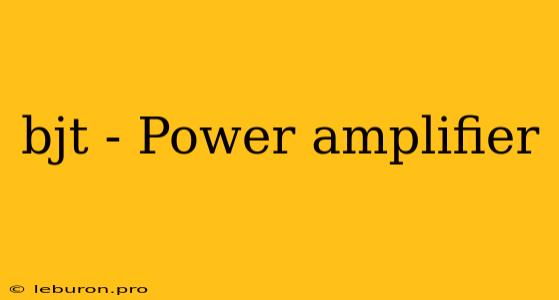Understanding the Power of BJTs: A Deep Dive into BJT Power Amplifiers
The world of electronics is built on the foundation of transistors, with bipolar junction transistors (BJTs) playing a crucial role in various applications. Among their many uses, BJTs excel in power amplification, a critical function for amplifying electrical signals to drive speakers, motors, and other demanding loads. This article will delve into the intricacies of BJT power amplifiers, exploring their operation, classifications, design considerations, and common applications.
The Fundamentals of BJT Power Amplifiers
At the heart of a BJT power amplifier lies the BJT, acting as a controlled switch that amplifies the input signal by regulating the flow of current through the output load. The BJT's unique characteristic of amplifying current makes it ideal for handling significant power levels. This power amplification is achieved by controlling the collector current, which is directly proportional to the base current.
Operating Classes of BJT Power Amplifiers
BJT power amplifiers are broadly categorized into different classes based on their conduction angle, which determines the proportion of the input signal cycle during which the transistor conducts. Each class exhibits distinct characteristics, affecting their efficiency, power output, and distortion levels:
-
Class A: This class operates with a conduction angle of 360 degrees, meaning the transistor conducts for the entire input signal cycle. This leads to high linearity and low distortion but results in low efficiency, as power is dissipated even when the input signal is inactive.
-
Class B: In Class B amplifiers, the transistor conducts for only half of the input signal cycle (180 degrees). This improves efficiency compared to Class A but introduces crossover distortion due to the gaps in conduction between transistors.
-
Class AB: This class combines the advantages of Class A and Class B, operating with a conduction angle between 180 and 360 degrees. Class AB amplifiers achieve a balance between linearity, efficiency, and distortion.
-
Class C: These amplifiers conduct for less than 180 degrees, leading to high efficiency but significant distortion. They are primarily used in radio frequency applications where distortion is less critical.
Design Considerations for BJT Power Amplifiers
Building a robust and reliable power amplifier requires careful consideration of several factors:
-
Biasing: Proper biasing ensures the BJT operates in the active region, maximizing its amplification potential. Bias point selection influences the output power, distortion, and stability of the amplifier.
-
Heat Dissipation: BJTs generate heat during operation, particularly at higher power levels. Adequate heat sinks are crucial to prevent overheating and ensure reliable operation.
-
Load Impedance Matching: Matching the amplifier's output impedance to the load impedance optimizes power transfer and minimizes signal reflection, leading to optimal performance.
-
Frequency Response: The frequency response of a power amplifier dictates its ability to amplify signals across different frequencies. Careful selection of components ensures a flat and wide frequency response, catering to the desired signal bandwidth.
-
Distortion: Distortion arises from nonlinearities in the amplifier circuit. Feedback techniques and proper component selection help minimize distortion, delivering a clean and undistorted output signal.
Applications of BJT Power Amplifiers
BJT power amplifiers find extensive use across various electronic systems and applications:
-
Audio Amplifiers: They are the workhorses of audio systems, amplifying music signals to drive speakers and headphones. Their ability to deliver high power with reasonable distortion makes them ideal for audio applications.
-
Radio Transmitters: In radio transmission, BJTs amplify radio frequency signals to transmit data over long distances.
-
Power Supplies: Power amplifiers can be used in voltage regulators and other power supply circuits to control the output voltage and current.
-
Motor Control: BJTs can drive motors by controlling their speed and direction, allowing for precise motor control in various applications.
-
Industrial Automation: BJTs are employed in industrial control systems, amplifying control signals to drive actuators and other components.
Conclusion
BJT power amplifiers are integral components in a wide array of electronics, playing a crucial role in amplifying signals and driving loads. Understanding their operation, characteristics, and design considerations is essential for achieving reliable and efficient power amplification. By carefully selecting the appropriate operating class, considering biasing, heat dissipation, load impedance matching, and frequency response, engineers can design powerful and versatile BJT power amplifiers that meet the demands of various applications. As technology evolves, the role of BJTs in power amplifiers will likely continue to be essential, driving advancements in various fields.
